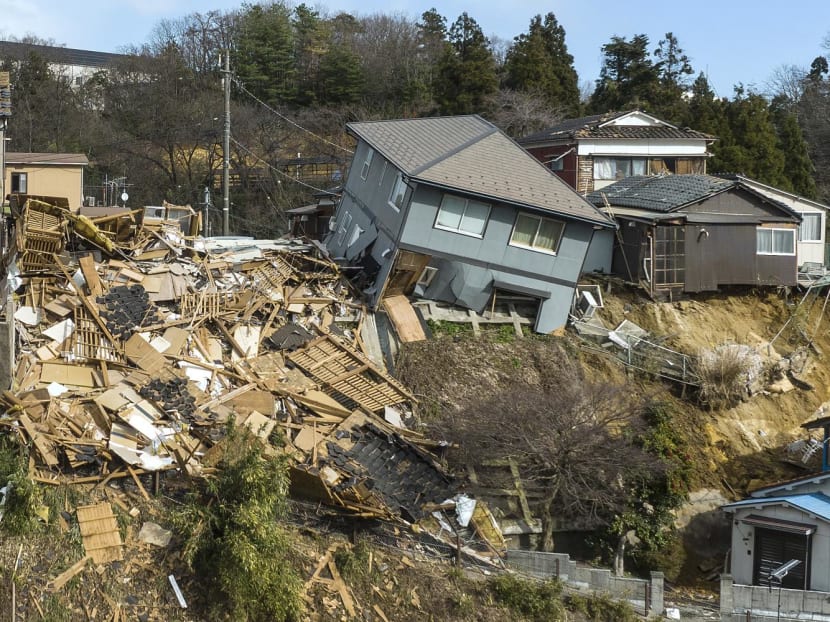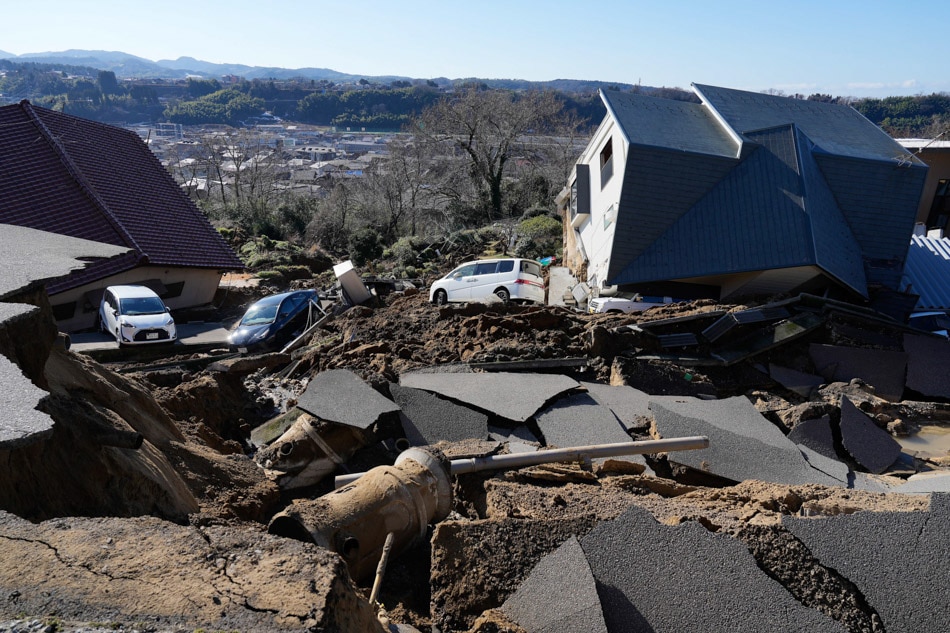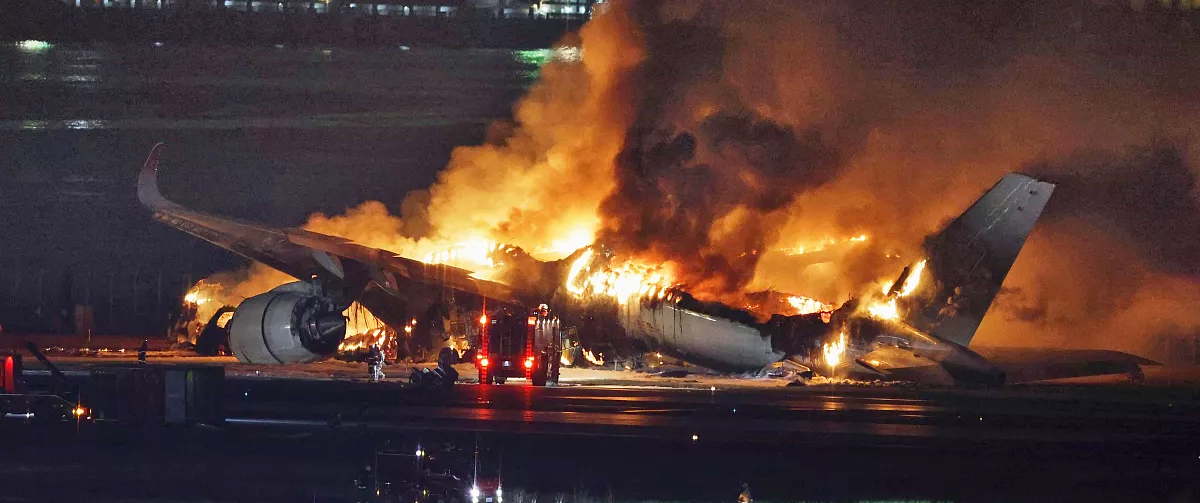A collision at Haneda Airport comes a day after a massive earthquake on New Year’s Day caused scores of fatalities and widespread damage on Japan’s west coast.
Japan woke up on the second day of 2024 coping with the aftermath of a devastating earthquake off its west coast only to face another disaster as a domestic Japan Airlines (JAL) flight collided with a Japan Coast Guard aircraft which was involved in the earthquake rescue and relief operations.
The passenger jet landed at Tokyo Haneda Airport, where it apparently collided with the Coast Guard plane, reported as a De Havilland Dash 8. The fully booked JAL plane, carrying nearly 400 passengers and crew, burst into flames, a massive fireball ultimately consuming the Airbus A350 widebody aircraft which had been inbound from Sapporo on the island of Hokkaido.

Though all of the 367 passengers and 12 crew were evacuated from JAL Flight 516 with no fatalities, five Coast Guard crewmembers from the relief flight were killed in the collision, with the lone survivor, the captain of that aircraft, reported as seriously injured.
The collision and subsequent fire destroyed both aircraft, but the incident is still under fresh investigation, so few details are known. What’s immediately clear, however, is that with a packed widebody A350, this all could have ended far more tragically. Sources shared that the completely full A350 was evacuated in just 96 seconds, a testament to the training and performance of the crew – and doubtlessly achieved in no small part to the laudable conduct of the passengers, as well.
COMPOUNDING THE TRAUMA
Of course, it’s still not a happy story. Apart from the shock and grief for the loved ones of those lost, the shocking accident only heightens the trauma roiling the nation of Japan after one of the worst quakes to hit the country since the catastrophic 2011 Tōhoku earthquake and tsunami, the fourth-most powerful quake in recorded history, which claimed over 19,000 lives and devasted cities and towns along Japan’s northeastern coast.
This time, the rapid succession of quakes hit the west coast, on the Sea of Japan. The strongest was a 7.5-magnitude tremor, near Noto, and at a relatively shallow depth (preliminary reported to be 16 km). Though the initial tsunami warnings were lifted within several hours, the dawn of the next day began to illuminate how much damage the violent shaking had done all on its own.

As the second day of the new year unfolded, the true scale of the destruction wrought by Monday’s earthquakes slowly trickled out to a waiting world.
Japanese authorities were swift in evaluating the aftermath of a serious earthquake which triggered landslides and building collapses, caused a substantial fire in a renowned tourist zone, and prompted a widespread major tsunami warning along the nation’s west coast. Ongoing aftershocks, coupled with obstructed roadways and damaged infrastructure, presented challenges to rescue operations as the urgent search for survivors unfolded.
So far, 48 deaths have been confirmed, a number expected to rise as the race against the clock goes on. Experts say the first 72 hours after a disaster are crucial for survival and rescue; after that, it largely becomes a recovery effort.
Japan’s Prime Minister, Fumio Kishida, announced that the government had established an emergency disaster local response headquarters in Ishikawa to both assess the situation and offer needed support.
“As time passes, the effect of the disaster is becoming more and more clear,” Kishida said. “Saving the lives of the disaster victims is a race against time.”
SCENES OF DESTRUCTION
NHK’s footage on Tuesday unveiled a disconcerting scene in Wajima, Ishikawa Prefecture, where a central area, celebrated for its morning market, saw a seven-story building toppled sideways, with smoke billowing from the debris. Social media imagesand videos depicted unsettling scenes of cars, houses, and bridges in Ishikawa trembling violently as terrified individuals sought refuge in shops and train stations. The quake left houses in ruins and roads torn apart by massive cracks, while landslides sent cars and buildings tumbling.
Over 200 structures in central Wajima were set ablaze, but officials in Ishikawa reported successful containment of most of the fires. Governor Hiroshi Hase shared in a social media statement that landslides or cracks in the ground had rendered numerous roads impassable, while in the Suzu port, multiple vessels had capsized amid the disaster.
Though initial reports of tsunami impacts were less serious than feared, there was still significant coastal damage and flooding. However, the devastation from the violent, shallow quake was extensive, as shown in the images below.






“It was such a powerful jolt,” said 73-year-old Tsugumasa Mihara to the local newspaper as he lined up with hundreds of others to wait for a precious six-litre allocation of water in the shellshocked town of Shika, where taps ran dry after Monday’s quake.
He later explained to an AFP reporter that, having given his grandchildren a traditional New Year’s Day gift of some pocket money, he was taking an afternoon nap when he was rattled awake by the earthquake. “I was just helpless… all I could do at the time was pray that it would end soon,” he said.
“What a terrible way to start the year.”
"ExpatGo welcomes and encourages comments, input, and divergent opinions. However, we kindly request that you use suitable language in your comments, and refrain from any sort of personal attack, hate speech, or disparaging rhetoric. Comments not in line with this are subject to removal from the site. "





















